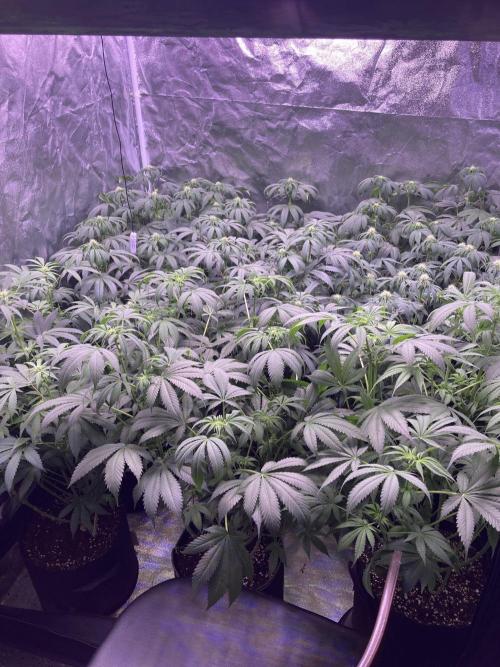The Grow Awards 2026 🏆 












Brown pistils at week 4 flowering
slowingstarted grow question 5y ago
Hi guys.
I'm at the end of the 4th week of flowering.
I'm a bit worrying about some "brown-ish" on some pistils.
Are they normal? The appear only on some flowers.
The distance from the light (200 watt cfl) Is around 8/10cm.
pH: 6.3
Please helpp! Thanks in advance
Solved
Buds. Other
likes
Organomananswered grow question 5y ago
Yes, pistils turning brown is a normal process. At the base of each pair of pistils and located inside the female calyx, is an ovule, that when fertilized, will grow into a seed. The white pistils indicate that the ovule at their base is still viable and fresh enough for successful pollination and fertilization. As the female flower ages, the ovules, which have also aged, have become less viable for successful fertilization, as indicated by the brown colour of the pistils. This is an adaptive response so that any pollen is more likely to land and be "trapped" on/by a plump and "juicy" white pistil, where fertilization will favour a fresh and viable ovule, rather than landing on/being trapped by a dried up brown pistil with an aged and less viable ovule at their base. This ensure pollen is not "wasted" by landing on pistils that have less viable ovules at their base and the pollen is most likely to be "trapped" / "caught" by the plump "juicier" white pistils, that have fresh and viable ovules at their base.
Fertilization, by the way, takes about 20-30 minutes from when the pollen grain(s) land on the pistil and the pollen tube or "sperm" grows down the pistil to reach the female ovule at the base of the pistils and for fertilization to occur and start the process of a seed developing. Fascinating stuff!
Hope this helps,.......
Organoman.
Darktideanswered grow question 5y ago
Some will have the pistils start turning brown early, which is normal.
Mine turned brown at 3 weeks into flower, and the buds are nice and fat.
A side note, careful with your PH as it is on the top side of the recommended.
Great Luck & Happy Growing 🍃
2 likes
Complain
DeadwebsiteBoringcommunityanswered grow question 5y ago
it's normal for pistils to brown off during later phases. Could very well be the limit of your light. a Cfl bulb with a 5k spectrum is not a good flowering bulb at all. Iv'e heard 1/4 outputs with fluorescents. That's just side info Iv'e read.. I do know that Vegging with Cfls is one thing.. But flowering with them is strongly discouraged because there is just not enough red light to promote bulk and growing.
2 likes
Complain
Similar Grow Questions
Solved

Viccrazyweed
Are these females?I don’t really know as it is my first growing indoor experience
Buds. Other
Leaves. Other
Plant. Other
3y ago
4
4
Solved

cnkice
No sign of flowering, see close up picturesGirls are looking really good but no sign of flowering. It has been 40 days from germination, please see close up pictures in week 5.
I learned from other websites that 12-12 light schedule could be used to initiate flowering.
Any suggestion?
Week 5
Buds. Other
6y ago
3
2
Solved

Homestickycannabis
Is this a particular phenotype of Dos si Dos 33.What do I have? I've searched all grow forums and have not come across a phenotype such as mine, a Dos si Dos 33 that is stacking some rater interesting fox tail flowers"not the bad kind". I'm not complaining at all,the buds are beautiful and frosty.
Week 12
Buds. Other
4y ago
3
6
Solved

Ghhandi
Warum lassen meine Mädels den Kopf hängen nach dem Gießen? Mal ernsthaft das hatte ich noch nie
Die stehen da wie ne eins
Freuen sich am licht
Da komm ich nach 4 Tagen mit der Gießkanne und gönne
Und die lassen für 3-4 Stunden die Köpfe hängen als würden sie eingehen
Buds. Other
5mo ago
5
3
Solved

Faust1a
Zdarec, přemýšlím nad tím že dále bych pokračoval s metodou SCROG. Kdy a jak s metodou nejlépe začít? A má to vůbec smysl v mém stanu 45x45x120 cm ? Děkuji za každou reakcí 😉 . MírBuds. Other
Techniques. LST
Techniques. ScrOG
5y ago
1
1
Solved

Moro_Callejero
Can you share your ideas about when to start harvest please? =D
Week 15
Buds. Other
5y ago
3
3
Solved

deepsheeba
Genetic mutation HiFi4g: Polyploidy or fasciation?Hi, I'm sorry if I'm doubling the question but I don't know how to add pictures in the old post. In the preiovus post some people wrote about polyploidy and others on fasciation. To my own internet research the difference seems pretty big in terms of productive and visual quality
Week 7
Buds. Other
3y ago
1
3




























